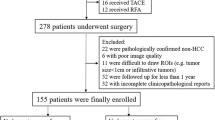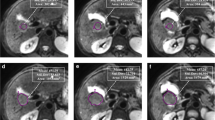Abstract
Purpose
To evaluate the role of whole-tumor radiomics analysis of apparent diffusion coefficient (ADC) maps in predicting early recurrence (ER) of solitary hepatocellular carcinoma (HCC) ≤ 5 cm and compare the diagnostic efficiency of whole-tumor and single-slice ADC measurements.
Methods
One hundred and seventy patients with primary HCC were randomly divided into the training set (n = 119) and the test set (n = 51). The diagnostic efficiency was compared between the whole-tumor and single-slice ADC measurements. The clinical–radiological model was established by selected significant clinical characteristics and qualitative imaging features. The radiomics model was constructed using the least absolute shrinkage and selection operator (LASSO) logistic regression algorithm. The significant clinical–radiological risk factors and radiomics features were integrated to develop the combined model. Receiver operating characteristic (ROC) curves were used for evaluating the predictive performance.
Results
Cirrhosis, age, and albumin were significantly associated with ER in the clinical–radiological model selected by the random forest classifier. The diagnostic efficiency of the whole-tumor ADC measurements was slight higher than that of the single-slice (AUC = 0.602 and 0.586, respectively). The clinical–radiological model (AUC = 0.84 and 0.82 in the training and test sets, respectively) showed better diagnostic performance than the radiomics model (AUC = 0.70 and 0.69 in the training and test sets, respectively) in predicting ER. The combined model showed optimal predictive performance with the highest AUC values of 0.88 and 0.85 in the training and test sets, respectively.
Conclusions
The whole-tumor ADC measurements performed better than the single-slice ADC measurements. The clinical–radiological model performed better than the radiomics model for predicting ER in patients with solitary HCC ≤ 5 cm.






Similar content being viewed by others
Abbreviations
- AdaBoost:
-
Adaptive boosting
- ADC:
-
Apparent diffusion coefficient
- AFP:
-
Alpha-fetoprotein
- ALB:
-
Albumin
- ANOVA:
-
Analysis of variance
- AUC:
-
Area under the curve
- CI:
-
Confidence interval
- DWI:
-
Diffusion-weighted imaging
- ER:
-
Early recurrence
- HCC:
-
Hepatocellular carcinoma
- ICC:
-
Intraclass correlation coefficient
- LASSO:
-
The least absolute shrinkage and selection operator
- LR:
-
Logistic regression
- MRI:
-
Magnetic resonance imaging
- RF:
-
Random forest
- ROC:
-
Receiver operating characteristic
- ROI:
-
Region of interest
- VOI:
-
Volume of interest
References
[1] Sung H, Ferlay J, Siegel RL et al (2021) Global Cancer Statistics 2020: GLOBOCAN Estimates of Incidence and Mortality Worldwide for 36 Cancers in 185 Countries. CA Cancer J Clin 71:209-249
[2] Chen W, Zheng R, Baade PD et al (2016) Cancer statistics in China, 2015. CA Cancer J Clin 66:115-132
[3] Wang JH, Wang CC, Hung CH, Chen CL, Lu SN (2012) Survival comparison between surgical resection and radiofrequency ablation for patients in BCLC very early/early stage hepatocellular carcinoma. Journal of Hepatology 56:412-418
[4] Portolani N, Coniglio A, Ghidoni S et al (2006) Early and late recurrence after liver resection for hepatocellular carcinoma: prognostic and therapeutic implications. Annals of Surgery 243:229-235
[5] Xu XF, Xing H, Han J et al (2019) Risk Factors, Patterns, and Outcomes of Late Recurrence After Liver Resection for Hepatocellular Carcinoma: A Multicenter Study From China. JAMA Surgery 154:209-217
[6] Gillies RJ, Kinahan PE, Hricak H (2016) Radiomics: Images Are More than Pictures, They Are Data. Radiology 278:563-577
[7] Ariizumi S, Kitagawa K, Kotera Y et al (2011) A non-smooth tumor margin in the hepatobiliary phase of gadoxetic acid disodium (Gd-EOB-DTPA)-enhanced magnetic resonance imaging predicts microscopic portal vein invasion, intrahepatic metastasis, and early recurrence after hepatectomy in patients with hepatocellular carcinoma. J Hepatobiliary Pancreat Sci 18:575-585
Zhang L, Kuang S, Chen J et al (2019) The Role of Preoperative Dynamic Contrast-enhanced 3.0-T MR Imaging in Predicting Early Recurrence in Patients With Early-Stage Hepatocellular Carcinomas After Curative Resection. Frontiers in Oncology 9:1336
[9] An C, Kim DW, Park YN, Chung YE, Rhee H, Kim MJ (2015) Single Hepatocellular Carcinoma: Preoperative MR Imaging to Predict Early Recurrence after Curative Resection. Radiology 276:433-443
[10] Ahn SJ, Kim JH, Park SJ, Kim ST, Han JK (2019) Hepatocellular carcinoma: preoperative gadoxetic acid-enhanced MR imaging can predict early recurrence after curative resection using image features and texture analysis. Abdom Radiol (NY) 44:539-548
[11] Lewis S, Dyvorne H, Cui Y, Taouli B (2014) Diffusion-weighted imaging of the liver: techniques and applications. Magn Reson Imaging Clin N Am 22:373-395
[12] Lee S, Kim SH, Hwang JA, Lee JE, Ha SY (2019) Pre-operative ADC predicts early recurrence of HCC after curative resection. European Radiology 29:1003-1012
[13] Ameli S, Shaghaghi M, Aliyari GM et al (2020) Role of baseline volumetric functional MRI in predicting histopathologic grade and patients' survival in hepatocellular carcinoma. European Radiology 30:3748-3758
[14] Kong C, Zhao Z, Chen W et al (2021) Prediction of tumor response via a pretreatment MRI radiomics-based nomogram in HCC treated with TACE. European Radiology 31:7500-7511
[15] Song W, Yu X, Guo D et al (2020) MRI-Based Radiomics: Associations With the Recurrence-Free Survival of Patients With Hepatocellular Carcinoma Treated With Conventional Transcatheter Arterial Chemoembolization. Journal of Magnetic Resonance Imaging 52:461-473
[16] Zhang Z, Jiang H, Chen J et al (2019) Hepatocellular carcinoma: radiomics nomogram on gadoxetic acid-enhanced MR imaging for early postoperative recurrence prediction. Cancer Imaging 19:22
[17] Yuan C, Wang Z, Gu D et al (2019) Prediction early recurrence of hepatocellular carcinoma eligible for curative ablation using a Radiomics nomogram. Cancer Imaging 19:21
[18] Lurie Y, Webb M, Cytter-Kuint R, Shteingart S, Lederkremer GZ (2015) Non-invasive diagnosis of liver fibrosis and cirrhosis. World J Gastroenterol 21:11567-11583
[19] Muhi A, Ichikawa T, Motosugi U et al (2013) Diffusion-weighted imaging of hepatocellular carcinoma for predicting early recurrence and survival after hepatectomy. Hepatology International 7:662-668
[20] Nakanishi M, Chuma M, Hige S et al (2012) Relationship between diffusion-weighted magnetic resonance imaging and histological tumor grading of hepatocellular carcinoma. Annals of Surgical Oncology 19:1302-1309
[21] Zhao Y, Wu J, Zhang Q et al (2021) Radiomics Analysis Based on Multiparametric MRI for Predicting Early Recurrence in Hepatocellular Carcinoma After Partial Hepatectomy. Journal of Magnetic Resonance Imaging 53:1066-1079
[22] Arita Y, Yoshida S, Kwee TC et al (2021) Diagnostic value of texture analysis of apparent diffusion coefficient maps for differentiating fat-poor angiomyolipoma from non-clear-cell renal cell carcinoma. European Journal of Radiology 143:109895
[23] Yin JD, Song LR, Lu HC, Zheng X (2020) Prediction of different stages of rectal cancer: Texture analysis based on diffusion-weighted images and apparent diffusion coefficient maps. World J Gastroenterol 26:2082-2096
[24] Omata M, Cheng AL, Kokudo N et al (2017) Asia-Pacific clinical practice guidelines on the management of hepatocellular carcinoma: a 2017 update. Hepatology International 11:317-370
[25] Nahm JH, Lee HS, Kim H et al (2021) Pathological predictive factors for late recurrence of hepatocellular carcinoma in chronic liver disease. Liver International 41:1662-1674
[26] Wang H, Wu MC, Cong WM (2019) Microvascular invasion predicts a poor prognosis of solitary hepatocellular carcinoma up to 2 cm based on propensity score matching analysis. Hepatology Research 49:344-354
[27] Li T, Fan J, Qin LX et al (2011) Risk factors, prognosis, and management of early and late intrahepatic recurrence after resection of primary clear cell carcinoma of the liver. Annals of Surgical Oncology 18:1955-1963
[28] Pompili M, Saviano A, de Matthaeis N et al (2013) Long-term effectiveness of resection and radiofrequency ablation for single hepatocellular carcinoma </=3 cm. Results of a multicenter Italian survey. Journal of Hepatology 59:89-97
[29] Chong HH, Yang L, Sheng RF et al (2021) Multi-scale and multi-parametric radiomics of gadoxetate disodium-enhanced MRI predicts microvascular invasion and outcome in patients with solitary hepatocellular carcinoma </= 5 cm. European Radiology 31:4824-4838
[30] Wu N, Chen G, Hu H, Pang L, Chen Z (2015) Low pretherapeutic serum albumin as a risk factor for poor outcome in esophageal squamous cell carcinomas. Nutrition and Cancer-An International Journal 67:481-485
[31] Gupta D, Lis CG (2010) Pretreatment serum albumin as a predictor of cancer survival: a systematic review of the epidemiological literature. Nutrition Journal 9:69
[32] Li B, Liu A, Wen Y et al (2021) The prognostic values of serum markers in hepatocellular carcinoma after invasive therapies based on real-world data. Journal of Clinical Laboratory Analysis 35:e23932
[33] Zeng J, Lin K, Liu H et al (2020) Prognosis Factors of Young Patients Undergoing Curative Resection for Hepatitis B Virus-Related Hepatocellular Carcinoma: A Multicenter Study. Cancer Management and Research 12:6597-6606
[34] Lai Y, Lee JC, Hung HC et al (2020) Models to predict disease-free survival for hepatocellular carcinoma patients with surgical resections. Journal of Surgical Oncology 122:1444-1452
Funding
This study was supported by the PUMC Youth Fund (Grant No. 2017320010).
Author information
Authors and Affiliations
Contributions
Conceptualization: LW and XM; methodology: LW and BF; formal analysis and investigation: LW, SW, JH, DL, ML, and SW; writing—original draft preparation: LW; writing—review and editing: XM and XZ; supervision: XZ.
Corresponding authors
Ethics declarations
Conflict of interest
The authors declare that they have no conflict of interest.
Ethical approval
This study was approved by our institutional review board.
Informed consent
The requirement for patient informed consent was waived due to the retrospective nature of this study.
Additional information
Publisher's Note
Springer Nature remains neutral with regard to jurisdictional claims in published maps and institutional affiliations.
Supplementary Information
Below is the link to the electronic supplementary material.
Rights and permissions
About this article
Cite this article
Wang, L., Feng, B., Wang, S. et al. Diagnostic value of whole-tumor apparent diffusion coefficient map radiomics analysis in predicting early recurrence of solitary hepatocellular carcinoma ≤ 5 cm. Abdom Radiol 47, 3290–3300 (2022). https://doi.org/10.1007/s00261-022-03582-6
Received:
Revised:
Accepted:
Published:
Issue Date:
DOI: https://doi.org/10.1007/s00261-022-03582-6




